Vision 2025 - National Research Centre for Grapes
Vision 2025 - National Research Centre for Grapes
Vision 2025 - National Research Centre for Grapes
You also want an ePaper? Increase the reach of your titles
YUMPU automatically turns print PDFs into web optimized ePapers that Google loves.
associations of various states, especially Maharashtra, Andhra Pradesh, Karnataka and Tamil<br />
Nadu besides state departments of agriculture/horticulture and other grape stake holders.<br />
The Scientists of the <strong>Centre</strong> are actively interacting with the grape growers during their field<br />
visits, seminars organized by the State Government and growers' associations, farmers fairs<br />
etc. and also during the visit of the growers to the <strong>Centre</strong>. Scientists participate in about 20-<br />
25 such seminars in a year in different grape growing areas. Scientists share the latest technical<br />
in<strong>for</strong>mation on various aspects of grape enterprise and also try to understand new problems<br />
faced by this sector and effectively disseminate technologies through various other media also.<br />
The <strong>Centre</strong> also has been conducting various training programmes on different aspects of<br />
viticulture. In association with State Bank of India, Pune the <strong>Centre</strong> has also adopted growers<br />
in different grape growing regions of Maharashtra to advice them on means to increase the<br />
production of quality grapes.<br />
To educate grape growers on newly emerging technologies / problems the <strong>Centre</strong> has<br />
published popular articles, research articles and technical bulletins and other institute<br />
publications. Till now, the <strong>Centre</strong> has generated 23 research articles, 110 popular articles, 5<br />
technical bulletins, one video CD and 5 other publications on various aspects of grape<br />
cultivation.<br />
So far the <strong>Centre</strong> has transferred the following technologies to the growers and these have been<br />
accepted well.<br />
• Irrigating grafted Thompson Seedless vines based on pan evaporation and growth stages.<br />
• Application of nutrients through drip in grafted Thompson Seedless vines.<br />
• Correction of nutritional disorders viz. Inward leaf curl (Potassium deficiency) and Bunch<br />
stem necrosis (Calcium and Magnesium deficiency) by appropriate nutrient application.<br />
• Moisture conservation techniques like mulching, subsurface irrigation and use of<br />
antitranspirant.<br />
• Use of Trichoderma <strong>for</strong> improving the post-harvest shelf life of grapes. The field results<br />
with Trichoderma are very encouraging especially in preventing decay occurring after preharvest<br />
rains. The technology is well accepted by the grape growers. The technology <strong>for</strong><br />
commercial production of Trichoderma suitable <strong>for</strong> spray in vineyards has been given to<br />
'MAHAGRAPES', a grape growers' cooperative society.<br />
• Disease <strong>for</strong>ecasting technique developed by the <strong>Centre</strong> is being used by the leading grape<br />
growing and processing societies, besides the Govt. of Maharashtra and Andhra Pradesh in<br />
their package of practices <strong>for</strong> disease management.<br />
• Harvesting, handling and other post-harvest practices to improve the shelf life of grapes is<br />
regularly taught to grape growers in training programmes, seminars, etc.<br />
• Other areas of management of canopy, diseases, insects, herbs, and quality of fruits have<br />
been covered in technology transfer including Integrated Pest Management (IPM),<br />
Integrated Nutrient Management (INM) etc.<br />
12





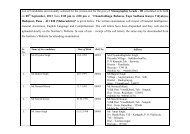
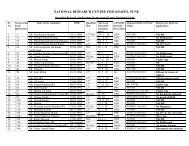

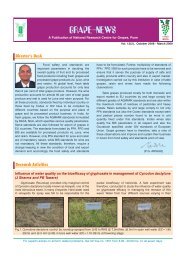

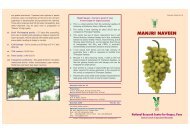
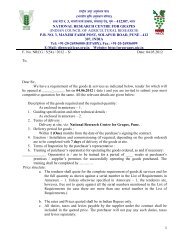



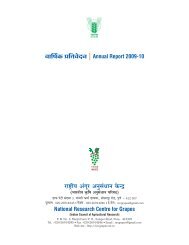
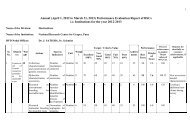
![mj]mJ{V cmcH$m{irM{ (_mBQâ¤>g) oZ`ÃÃU](https://img.yumpu.com/33367555/1/190x127/mjmjv-cmchmirm-mbqag-ozaau.jpg?quality=85)